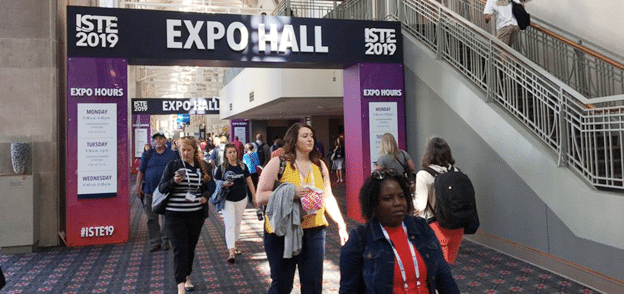ISTE 2019: CTOs Return to “Bootcamp,” Advocating for Tech and More

Credit: Roger Riddell/Education Dive
The following is an excerpt from an article originally published in Education Dive and is reprinted with permission. The article summarizes the 2019 annual International Society for Technology in Education (ISTE) conference in June.
Prepping new student teachers for digital learning
In a Monday morning session, ISTE Standards Senior Director Carolyn Sykora, ISTE Higher Education Recognition Program Lead Reviewer Sarah McPherson and the Fairfield University Graduate School of Education and Allied Professions’ Joshua Elliott detailed how ISTE is working with teacher preparation programs to recognize their quality and provide a simpler path to the ISTE Certification for Educators.
According to data from the U.S. Department of Education cited by Sykora, 146,000 graduate degrees in education were awarded in 2016, and there were 451,000 pre-service educators in 2014. The department also made a higher ed policy addendum to its National Education Technology Plan, to which Sykora noted there’s a lot of alignment between recommendations and the ISTE Standards for Educators and Students.
That’s noteworthy, given that a number of states—including Wisconsin, Michigan, Connecticut, Vermont, Texas, Washington, Delaware, Iowa, Utah, New York, Wyoming and Arkansas—and individual districts are adopting the standards.
ISTE’s vision for its higher ed work is to help teacher preparation programs graduate educators with the skills they need to successfully use tech for learning. By targeting pre-service programs, they can reach more educators early in their careers, get the standards in required classes rather than electives, and pivot from referencing the standards to requiring candidates to put the standards into practice, the speakers said.
With the ISTE Higher Ed Recognition Program, teacher prep programs have an additional avenue to be recognized as developing and graduating candidates with skills aligned to those standards. According to information on ISTE’s website, it includes
- Alignment review conducted by ISTE Standards experts, along with a full alignment report.
- Optional consulting services for faculty teams from ISTE Standards experts.
- Recognition from ISTE.
- The opportunity to pursue becoming a higher education ISTE certification provider.
This recognition benefits students by equipping them with tech proficiency, a higher advantage in the job market, and the skills for ed tech leadership roles. For the programs, it can show strengths, weaknesses and areas for change, in addition to making programs stand out and possibly grow enrollment, Elliott said.
At a media breakfast earlier in the morning, ISTE’s Culatta also stated that graduates from such programs would need only submit their portfolios to apply for ISTE certification (which was clarified during this session as carrying a $200 fee in this case), rather than going through the normal process. Elliott noted that Fairfield University is “still grappling” with whether to embed certification fees in course costs or to make certification an option that isn’t conditional for graduation, with students preparing their portfolios across the four courses involved regardless.
Computational thinking stretches across curriculum
What is computational thinking? How is it different from computer science? Where does it fit in curriculum? How do I measure it?
In an afternoon session, ISTE Computer Science Advisor and Govern For America Co-Founder and CEO Octavia Abell and Friday Institute for Educational Innovation Senior Director for Computer Science Initiatives Dave Frye tackled these questions.
Advocate for the change you seek in your district
Wondering how to raise $20 million for the pilot program you’ve been working on? Struggling to get a seat at the table and play politics for the benefit of your school district?
An afternoon session with two state board of education members and the executive director for the Virginia Society for Technology in Education (VSTE) addressed how school leaders and educators can be effective policy advocates for the change they envision on local and state levels.
Keep an eye out in the coming days for a full recap of the panel.
CTOs return to bootcamp
In what’s become one of our favorite recurring IT sessions at the annual ISTE conference, Jeremy Shorr of the Teaching Institute for Excellence in STEM led a group of K-12 district tech leaders through a discussion about their challenges and best practices.
Continue reading the full article.
Tags: advocacy, events, technology






